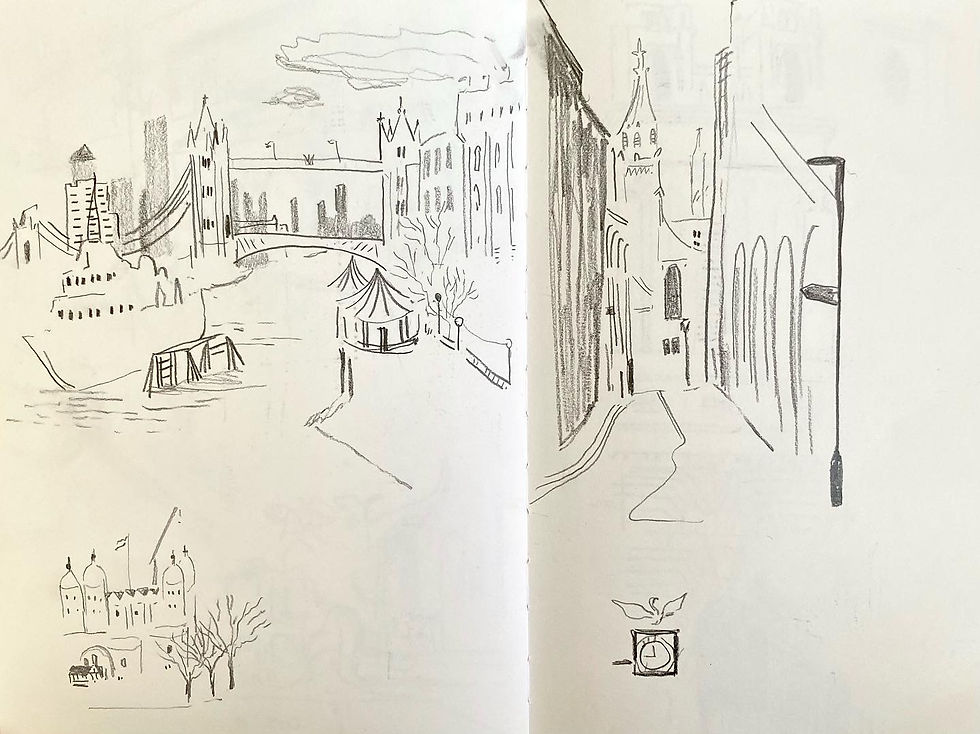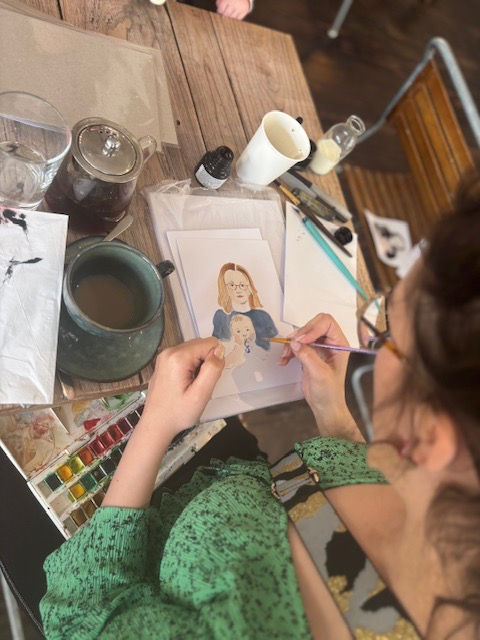What I learnt illustrating my first book
- wrightcarys

- Oct 2, 2023
- 5 min read
Updated: Apr 3, 2024
The first half of this year was probably the busiest I've yet to experience. So much so that while I've shared some images from a project I completed in the Spring,'The Curious Cat and the Lord Mayor's Show' by Christy White-Spunner, I have yet to share a blog on it. So here we are, six months down the line looking back.
I learnt a lot from this project, and I wanted to share some of this with you here. Maybe like me you're an illustrator who's just started to work in books, or maybe you're more seasoned but curious to know a bit more about how I work. Either way I hope this is interesting, and for those of you that don't work with books at all I'm curious if this is what you thought illustrating a book is like!
Firstly I had an assistant for this book, who was the expert in all things cat. Maybe this was cheating, but I like to think of it as research.

Drawing from life is always relevant
The book takes place in a version of London that's inhabited totally by talking animals, so I'd thought at first that I wouldn't need to use my observational drawing practice. I should have known better! When I came to rough out compositions, I really struggled with buildings and scale - particularly when I wanted to include some real landmarks that feature in the story.
So I set off with my sketchbook on a very windy day to draw on London Bridge and around Mansion House and Fleet Street. My drawings were basic but they did that magic thing of making me really look at what was in front of me. From looking and drawing on location, I got back to my desk able to look at my sketch and re-experience looking at those buildings I hadn't been able to conjure up in my imagination. I reaised that even in non-naturalistic projects, my sketchbook will always be there to use as reference and a guide. I talk more about the benefits of observational drawing in another blog post.

Words and pictures must work together
Now this one sounds very obvious, but it wasn't until I came to do the design myself as part of this brief that I came to fully appreciate what I'd been told about the interplay between text and image. I'm not saying I got it right 100% of the time in this book - but it certainly taught me a lot.
I had a lot of frustration when I had painted an image only to find that the text didn't have enough space, wasn't visible enough or looked drowned by white. It was satisfying to try and solve these issues but gosh did I want to throw my computer out of the window at one point! I had used InDesign before but this really put my knowledge to the test. It's a skillset I've come to really appreciate in the months since finishing the project.
A limited palette saves you time and heartache
I love colour. Sometimes I love it so much I want to put alll the colours into an artwork. But sometimes less really is more. I learnt about colour theory from The Goodship Illustration and Tania Willis' wonderful workshop (which you can do yourself here) and this has helped my work a lot. I try and set parameters for colour - for example choosing 3-7 colours for a piece of work reather than 37.
In this book, I chose a limited colour palette that I felt reflected the spirit of London - I needed a bright red in there, I had a yellow for the gold around the City of London, and I combined these with some blues and greys for the sky and landscape.

Having set parameters took away some decision anxiety, and also meant that all of the pages worked together as a whole - which is very important in a picture book. There is a lot of white space in the book, which again I felt worked best with a limited palette. In the picture above you can see I painted with my colour reference swatches always in sight.
Use materials that you're comfortable with
I toyed with the idea of doing the picture book artwork for 'The Curious Cat and the Lord Mayor's Show' digitally. I thought perhaps this would be easier and quicker. But then I realised that I was overcomplicating things - I know painting best so I chose to paint the book. I also find it challenging to maintain my visual style in digital. I'm working on this, and perhaps improved on this since finishing the book, but I wasn't 100% sure what a digital book would look like, whereas I knew what my paintings would look like.
Working with a familiar material was great. Of course, painting the artwork can make the process longer - especially if there are big changes. I made sure to send quite detailed roughs in 2 rounds so that the rest of the team could see what I was planning. I made the first set digitally for ease, and the second I made by hand at true scale to help me understand the level of detail I could use. I was lucky and had no major changes to make. Once I painted everything on paper, I scanned the pages and tweaked them in photoshop and procreate.

Make timelines work for you
A question I often hear asked at illustration talks is 'how long does it take to illustrate a book?'. I've also wondered this, and have sciblled various answers in my notebooks hoping to hear the perfect formula. It seems like a real-life version of the cliche how long is a piece of string. What I discovered from working on this book is that how long you spend on a book isn't always up to you, so you need to be adaptable.
I was invited onto the project about 4 months before the artowrk was due, and I ended up having about 6 weeks to create the finals once the story was complete. We had also recently moved house and everything was a bit topsy turvy! It was a tight timeline - I won't say it wasn't. But it worked out! So my takeaway here is no matter what time frame you're given you've got to make it work for you. The benefit of working fast was I had no time to overthink my decisions - and this was very useful as I think had I had lots of time I'd have doubted myself and perhaps overworked the art.
Enjoy it!
Having wanted to illustrate a book for many years, I reminded myself throughout the process how exciting it was to be enacting that desire. This helped me in moments where I wasn't sure if I'd meet my deadlines.
I feel like every book will be a bit different, and have its own flow, but this has been a great start. I'm intrigued to see how my approach might change over the years.




Comments